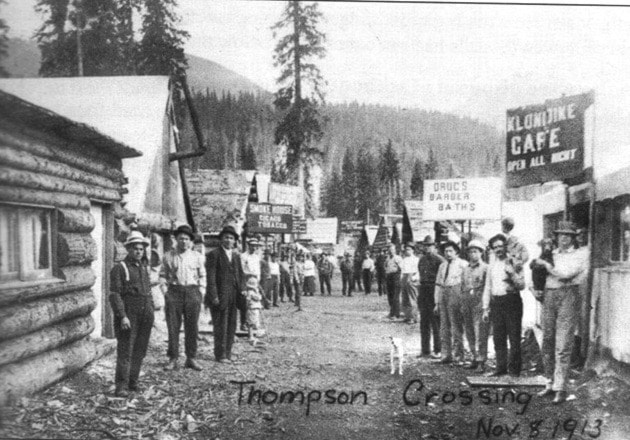Eleanor Deckert
Part five in a series celebrating 100 years of railroading history in the North Thompson Valley, 1915 – 2015
Confidence was high in the April 1, 1912 issue of the Inland Sentinel:“We will have at least 100 miles of roadbed on the North Thompson completed before next fall.”
The work
Opportunities to earn money parallel to the railroad construction included: running a post office or store, hauling freight, blacksmith to look after the pack animals, supplying wood, water and coal.
Bolton's cabin-sized store and post office at the Mile 44 bridge was an example of how entrepreneurs took advantage of the opportunities. G. Nipes advertised “Store-and-More: meals 50c, beds 50c.”
Charlie and son, Ernie Dee, made eight-day trips into Kamloops to bring supplies up to the Clearwater railroad camp. Two freight wagons each could carry two tons. If they came to a place where the grade was steep or slippery, they would unhitch one team and together haul one wagon, go back for the other.
Wood was needed by the cookhouses, as well as thousands of ties. 284 fir ties could be cut in a 10-hour day (each weighting 186 pounds) with machinery run by a Titan with tractor using 15 gallons of coal oil.
A constant supply of water and coal would be needed by the steam driven equipment and for every passing locomotive. Water towers were built near a creek or well. A heater under the tower had to be maintained to keep the water from freezing.
In 1910, a discovery of coal at Mosquito Flat (now Blackpool) brought high hopes for a local supply. The Canadian Coal and Coke Company sold shares, brought in a huge drill, leased land, and went down 278 feet, but did not find a good coal bed.
The men
Unlike the rail construction in the USA, the CNR line employed no Chinese workers. European immigrants were the labor force. Not all were English speaking and tension was part of camp life.
In the early 1900s muscles of men and animals provided the work. Camps along the road bed housed the men in log and canvas bunkhouses, the animals in crude shelters, even the cook houses and hospitals (which were legally required) were built of log and canvas.
The bunkhouses are described as crawling with lice and smelly because the men slept in their work clothes. They had no time or energy for laundry and bathing.
Food delivery, storage and preparation had its own challenges.
Jim Struthers drove 150 miles to Blue River, protecting potatoes from freezing in winter in a load of hay.
The Peavine cookhouse prepared food for 80 men at every meal.
Without refrigeration, butchering was on-going. And interesting fact: Butcher Island is now named Birch Island.
Three hospitals were located along the North Thompson River. Near the Albreda River was a 50-bed hospital, doctor, assistant and orderly. The Peavine camp boasted a doctor and a 30-bed hospital and even a dental chair. Chu Chua had a 25-bed hospital and one doctor. Royal Inland Hospital in Kamloops covered any other needs.
Living conditions were so unpleasant that the Inland Sentinel, January 27, 1912, issue reports that a 4,500 name petition was sent to the Dominion and provincial governments. The camps were described as unsanitary, the bunkhouses unfit for human habitation, and a request was made for hospital equipment to be brought up to standards. Special note was made of the difficulties during winter conditions.
Pay days
Wages have been recorded as 20c per day for pick and shovel.
Like any other time and place in history, camp followers set up their wares nearby. Moonshine prepared in hillside stills, girls for hire, gambling and preachers all came to pry the workers' wages from their pockets. Police records speak of fights, injuries and handcuffing a drunk around tree until he sobered up.
Foley, Welch and Stewart were the main contractors for the railroad at this time and place. Known by their workers as "Fool 'em, Work 'em and Starve 'em" a quote from a letter dated 1995, written by Noel Montagnon Jr. tells of his father's 1913 memories of Peavine camp. The pattern seems to be that men were hired in Kamloops, rode the steamer S.S. Distributor up river, worked to pay for their fare and room and board, then, at the break-even point, they were fired and told to walk back to Kamloops. There seems to have been a fairly constant stream of men walking south along the river bank, only to be hired back on from Kamloops.
Unrest among the men
The Inland Sentinel, January 27, 1912, issue describes how “Unrest among the men was aggravated through the propaganda distributed by the Industrial Workers of the World.”
Again, on page one of the April 8, 1912 Inland Sentinel announces a “Construction Worker Strike.”
Unions were beginning to form. Replacing of brutal foreman, expectations of fair pay and safe working conditions all became part of the demands for respect between workers and the company and boss.
Illness, injury and death were realities for the crews along the rail way line.
Contagion in camp caused by outhouse waste contaminating the drinking water supply brought a typhoid epidemic to Louis Creek in 1913, and 17 typhoid victims were killed at Red Pass towards Jasper by a corpse found in a creek.
Explosions caused injury and death. Falling rock or equipment, derailments and even one knife wound caused deaths that were recorded. However, there are also rumors of burials at track side, unceremoniously dug by the steam shovel, unmarked, mourned.
The year 1916 brought the Workman's Compensation Act to British Columbia ... a little late for some workers, but of benefit to all railroaders since.
